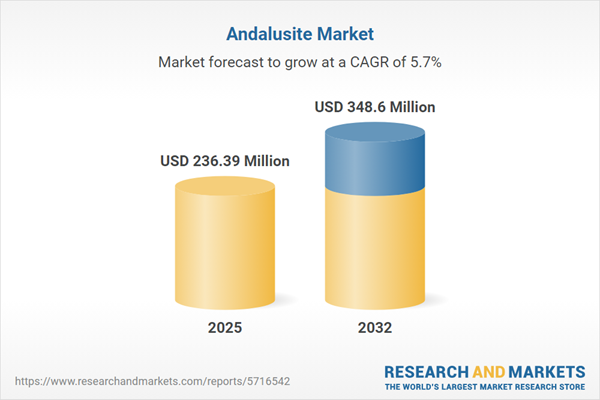Speak directly to the analyst to clarify any post sales queries you may have.
The global andalusite market is undergoing substantial transformation as industries increasingly prioritize advanced heat-resistant minerals for modern manufacturing. Senior executives face a dynamic landscape shaped by evolving supply chains and technological advancements.
Market Snapshot: Andalusite Market Size & Growth Outlook
The andalusite market is experiencing a phase of steady expansion, with recent valuations indicating sustained growth momentum. Market projections for the coming years reflect rising global demand for high-performance mineral solutions in industrial manufacturing. Andalusite’s unique ability to withstand elevated temperatures supports its pivotal use in sectors such as infrastructure development, advanced ceramics, and high-stress manufacturing. These trends underscore the mineral’s essential place in supply chains supporting critical equipment and structural components. Ongoing innovation responds directly to the need for dependable, quality materials across these domains.
Scope & Segmentation
This report provides senior decision-makers with actionable insights for investment, procurement, and market expansion in the global andalusite market. Comprehensive segmentation sheds light on competitive dynamics, highlighting the following influential factors:
- Application Areas: Cement castables, monolithic products, and refractory bricks are essential in supporting equipment and structures that demand high heat resistance and long-term durability in harsh operating conditions.
- End-Use Industries: Sectors such as ceramics manufacturing, foundry operations including investment casting and sand core production, as well as broader refractory applications, enhance resilience and deliver improved product outcomes in finished goods.
- Grade Variations: Distinctions among industrial, metallurgical, and premium refractory grades allow for customization based on technical and end-use needs, supporting applications from large-scale steel production to precise specialty ceramics.
- Sales Channels: Direct procurement models, distributor alliances, and digital retailing platforms each address shifting customer expectations for supply flexibility and reliable access to critical mineral inputs.
- Type: Both granular lumps, preferred for brickmaking and sintering, and finely milled powders, suitable for castables and specialty ceramics, cater to a spectrum of manufacturing requirements.
- Regional Analysis: Markets across North America, Latin America, Europe, Middle East & Africa, and Asia-Pacific each present unique decision factors. These include availability of raw materials, infrastructure maturity, and evolving local regulations that influence procurement and investment approaches.
- Technologies & Innovations: Adoption of additive manufacturing, implementation of digital twin modeling, advancement in kiln technologies, and focus on recycling are collectively raising production standards and reducing environmental impact.
- Company Coverage: Major industry participants including Andalucita S.A., Imerys S.A., LKAB Minerals, Latin Resources, Resco Products, Shijiazhuang Mining, and Keyhan Payesh Alvand are analyzed for recent product innovations, core operational strengths, and regional market strategies.
Key Takeaways for Senior Decision-Makers
- Deployment of digital quality management and additive manufacturing is improving the consistency and reliability of manufacturing processes, allowing for ongoing material optimization within core sectors.
- Increasing focus on environmental regulations is accelerating the transition toward more energy-efficient production and expanded recycling initiatives at every stage of the supply cycle.
- Continuous product development and refined service models are necessary for industry players to remain competitive as alternative high-alumina materials challenge traditional andalusite roles in several markets.
- Regional dynamics require tailored analysis, with factors such as raw material access, infrastructure expansion, and local policy developments directly shaping distribution and procurement tactics.
- Collaboration across technology suppliers and key industry users fosters ongoing R&D, reinforces reliability in supply relationships, and helps organizations build resilient, forward-focused supply chains.
Tariff Impact and Supply Chain Adaptation
The introduction of new U.S. tariffs on imported refractories in 2025 has led to increased procurement costs for many businesses reliant on andalusite. To counter these developments, organizations are renegotiating supplier agreements, forming diversified sourcing partnerships beyond traditional producers, and identifying new trade corridors. These adaptive measures are proving crucial for end users in sectors such as steelmaking and cement production, where operational stability relies on consistent, high-temperature materials. Effective supplier diversification and logistical agility are now central to maintaining cost control and operational continuity under shifting tariff structures.
Methodology & Data Sources
Findings in this report are drawn from targeted interviews with mineral producers, manufacturers, and end users, alongside in-depth analysis of trade statistics, corporate disclosures, scientific literature, and industry-specific studies. Expert triangulation and advanced market research methodologies ensure conclusions meet executive decision-making standards.
Why This Report Matters
- Supports leadership in anticipating and addressing supply chain disruptions, regulatory shifts, and tariff-driven changes within the evolving andalusite market.
- Provides actionable segmentation and authoritative regional insight to underpin informed choices on market entry, expansion, and compliance with sustainability requirements.
- Spotlights opportunities for process innovation, emphasizing digital transformation and the adoption of lower-carbon technologies to align with contemporary manufacturing priorities.
Conclusion
Robust and timely market intelligence equips senior executives to reinforce operational resilience, ensure supply chain stability, and navigate changes confidently in the high-temperature minerals sector.
Additional Product Information:
- Purchase of this report includes 1 year online access with quarterly updates.
- This report can be updated on request. Please contact our Customer Experience team using the Ask a Question widget on our website.
Table of Contents
3. Executive Summary
4. Market Overview
7. Cumulative Impact of Artificial Intelligence 2025
List of Figures
Samples

LOADING...
Companies Mentioned
The key companies profiled in this Andalusite market report include:- Andalucita S.A.
- Imerys S.A.
- LKAB Minerals
- Latin Resources
- Resco Products
- Shijiazhuang Mining
- Keyhan Payesh Alvand
Table Information
| Report Attribute | Details |
|---|---|
| No. of Pages | 195 |
| Published | October 2025 |
| Forecast Period | 2025 - 2032 |
| Estimated Market Value ( USD | $ 236.39 Million |
| Forecasted Market Value ( USD | $ 348.6 Million |
| Compound Annual Growth Rate | 5.7% |
| Regions Covered | Global |
| No. of Companies Mentioned | 8 |









